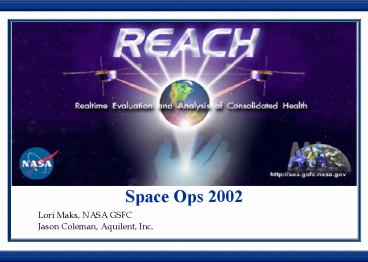Space Ops 2002 - PowerPoint PPT Presentation
1 / 21
Title:
Space Ops 2002
Description:
GSFC: Love-Leigh Beasley, Cameron Jerry, John Jung, Lori Maks. Aquilent: Jeff Burch, Xuewu Cai, Jason Coleman, Darren Gemoets , Kevin Hughes, ... – PowerPoint PPT presentation
Number of Views:26
Avg rating:3.0/5.0
Title: Space Ops 2002
1
Space Ops 2002
Lori Maks, NASA GSFC Jason Coleman, Aquilent,
Inc.
2
Agenda
- Overview
- Technical Description
- Installations
- Current Challenges
- Future Directions
- Acknowledgements
3
Overview (1)
- REACH is a visualization tool that allows an ops
team to monitor real-time telemetry for multiple
spacecraft on one screen - Originally designed to support constellation
missions of up to 100 spacecraft - Project scope has shifted to focus on any
multi-spacecraft mission, not just large
constellations
4
Overview (2)
- Provides simple health modeling
- High-level indicators spur further investigation
of low-level anomalies - Supports as much functionality as possible out
of the box - Not an expert system
- Uses red/yellow limits from existing telemetry
database - Developing the model takes days or weeks, not
months or years - Includes utilities to generate a default mission
model based on thresholds defined in the mission
database
5
Overview (3)
- Installed in the Small Explorers (SMEX) mission
operations center - 4 s/c pseudo-mission SWAS, TRACE, WIRE, SAMPEX
- Flight Ops team participating in usability study
- NASA MIDEX and Air Force TechSat-21 collaboration
- REACH v1.0 available for download
- http//invision.gsfc.nasa.gov/avatar/
- Browse to Projects page and select REACH
6
ITOS Console for 1 S/C
7
REACH Console for 100 S/C
8
The Mission Model
- Hierarchical model of the mission
- Subsystem health expressed as an index from 0 to
100 - Methods for calculating health are defined for
each node - Propagates low-level anomalies at configurable
intervals up the model hierarchy - Equation dependencies not bound by model
structure - Designed to be simple compared to an expert
system - Built-in rules (average, least, threshold lookup)
- Threshold lookup is SMEX-specific in v1.0 alpha
- Script entry for more sophisticated behavior
- Model API for integration with third-party tool
9
The Mission Model Generator
- Creates default model based on mission database
- Model has same subsystem hierarchy
- Node for each TLM mnemonic which has defined
limits - Health is based on limit lookup
- Subsystem node averages health of its TLM nodes
- Additional tools
- Generate VisAGE 2000 XML from existing telemetry
database (ITOS-specific) - One file per spacecraft
- Combine these files into one file with unique
mnemonic names
10
The Client Console
- Provides UI to explore the Mission Model and view
underlying telemetry - Main Console features
- Represents health red (lt34) yellow (34-67)
green (gt67) - Executive Summary, Mission Browser, Mission Grid
- Visualizations support color palettes to show
contact status - However, visibility framework is incomplete in
v1.0 alpha - Direct drill-down to Details Window
- View sorted TLM contributors, dependent nodes,
equation - Also features Abacus, Bullseye, Carousel,
Fisheye, and ScatterVis
11
The REACH Client Console
12
The Mission Model Editor
- Create, Edit, and Save model hierarchy and
equations - Lists telemetry mnemonics for selection in
equations - Supports both tree and list views
- Supports the built-in REACH rules and JavaScript
entry - Validates JavaScript and checks for circular
dependencies - Not implemented in alpha release
13
Model Editor
Node editor
Tree and List View of Model
14
Third-Party Example
The ACS of a particular spacecraft is extremely
complicated to model, so we defer to a
third-party tool. This is expressed below in
pseudocode and JavaScript
15
The REACH Server
- Interfaces with all other REACH components
- Manages connections to multiple data sources and
provides unified API to access the consolidated
data - Infrastructure to receive orbit/scheduling data
for propagation to the Client - Sends snapshots of telemetry data to Mission
Model - Receives health data in return
- Distributes telemetry and health data to Client
Console - Telemetry sent in near real-time or in intervals
- Can serve multiple client views into the model
- Such as to divide mission up amongst team members
16
Putting It Together
- Telemetry Sources provide raw data to be used in
Mission Model Health calculations - REACH Server provides access to consolidated
telemetry and model data - Mission Model Engine performs interval-based
calculations to derive Health indices from
spacecraft telemetry - Third Party Health Data Source represents
components such as GenSAA/GenIE or Altairis - REACH Client provides UI to explore the Mission
Model and underlying telemetry
17
High Level System Architecture
WinNT
REACH Server
Abstract Interface
REACH Client
HP/UX
Solaris
LAN
LAN
Ground System Client and REACH Client
Ground System Servers
Server Tier
Data Tier
Client Tier
18
Expertise
- Visualization of information
- 2D/3D visualizations
- Zoomable user interfaces (ZUI)
- Technology
- Pure Java for last three years
- Worked with Human/Computer Interaction Lab at
UMCP - Recurring report on state-of-the-art
visualization technology in industry
19
Current Installations
- Small Explorer (SMEX) Missions
- REACH is installed in the SMEX MOC. SMEX FOT are
evaluating the health modeling concept. FOT also
participating in usability testing of
visualizations. - Medium Explorer (MIDEX) Missions
- Installation scheduled for Summer/Fall 2002
- Air Force TechSat-21 Mission
- REACH selected as visualization component of
open-architecture, message-based ground system
20
Future Directions
- Add tools and support for other ground systems
- Eclipse
- ASIST
- Excel-style equation entry
- Historical health/TLM in equations
- REACH Server GUI
- Contact status support (s/c visibility)
- Implement client-side view selection
21
Acknowledgements
- Direction
- Julie Breed, GSFC Code 588
- Lori Maks, GSFC Code 588
- Collaboration/Support
- Maureen Madden and the SMEX FOT
- Prof. Ben Bederson, UMCP Human-Computer
Interaction Lab - Developers
- GSFC Love-Leigh Beasley, Cameron Jerry, John
Jung, Lori Maks - Aquilent Jeff Burch, Xuewu Cai, Jason Coleman,
Darren Gemoets , Kevin Hughes, Halil Kilicoglu,
Peter Matas, Vasili Rezapkin































